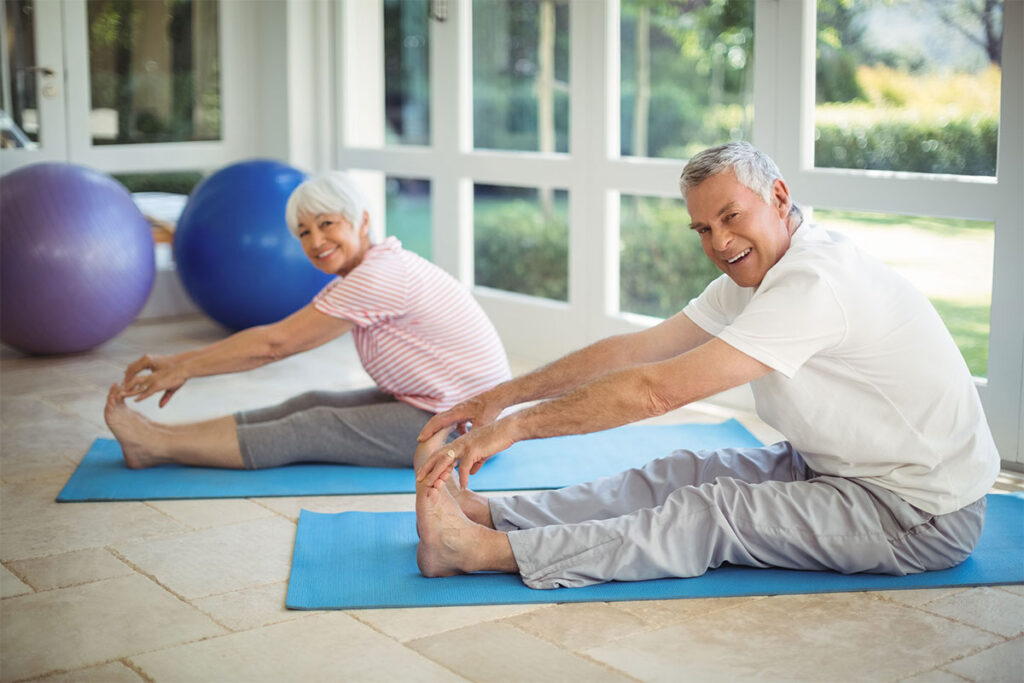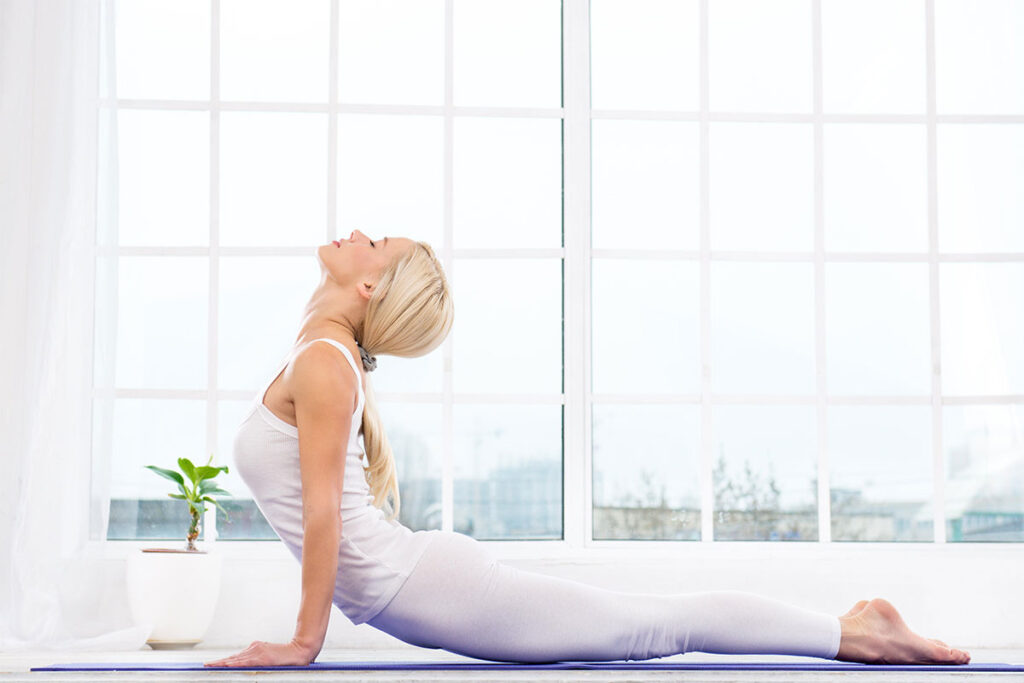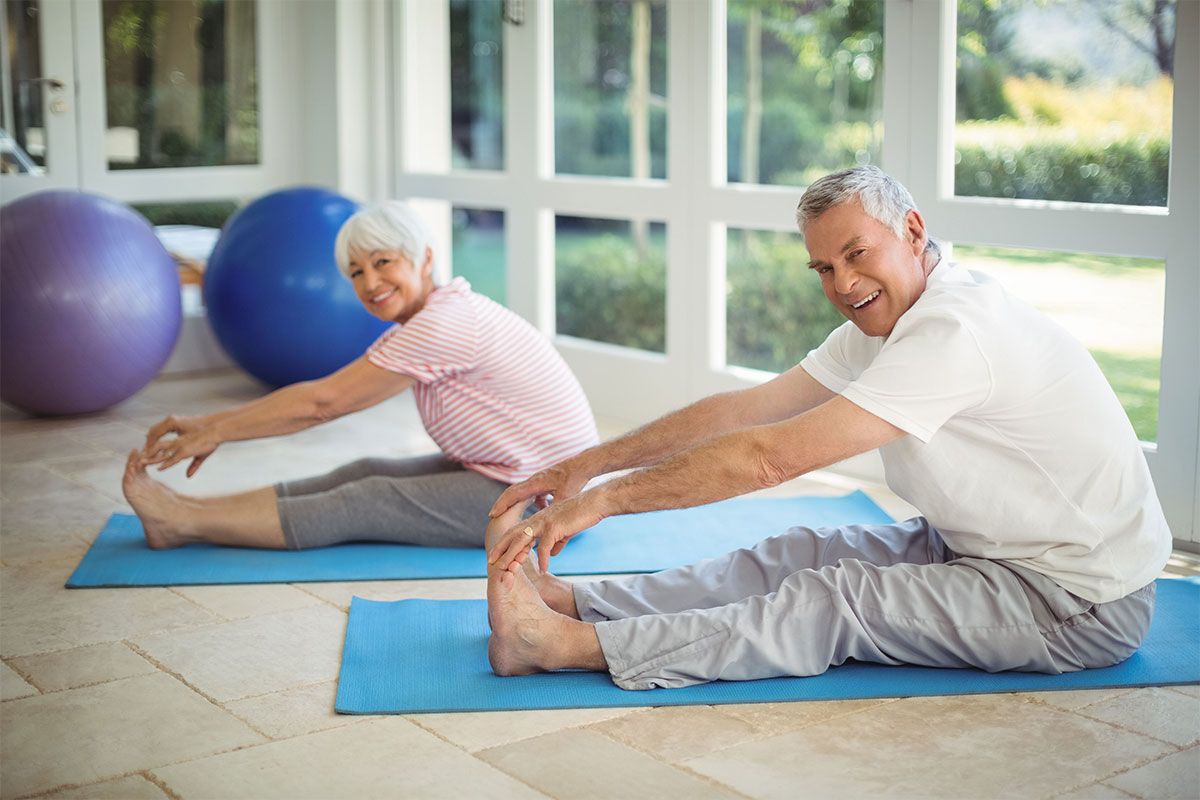As we age, maintaining joint health becomes increasingly important. For individuals over 50, finding the right exercises that are gentle on the joints while still improving mobility, reducing pain, and maintaining overall health can make a significant difference in quality of life. Low-impact exercises provide an excellent solution, offering all the benefits of physical activity without placing unnecessary stress on the body. In this comprehensive guide, we’ll explore the best low-impact exercises for joint health after 50, their benefits, and how to incorporate them into your routine.

Why Low-Impact Exercises Are Essential for Joint Health
Joint pain and stiffness often accompany aging, primarily due to conditions like arthritis, decreased cartilage, or simply years of wear and tear. High-impact activities, such as running or jumping, can exacerbate these issues, leading to further discomfort or even injury. Low-impact exercises, on the other hand, allow you to stay active while protecting your joints. These exercises focus on controlled movements, balance, and strengthening muscles that support the joints.
Benefits of Low-Impact Exercises
- Reduced Joint Pain: Gentle movements prevent undue stress on sensitive joints.
- Improved Mobility: Regular exercise keeps joints flexible and reduces stiffness.
- Increased Muscle Support: Strengthening surrounding muscles alleviates pressure on joints.
- Cardiovascular Health: Low-impact activities improve heart health without overwhelming the body.
- Better Weight Management: Maintaining a healthy weight reduces joint strain.
1. Swimming: A Joint-Friendly Full-Body Workout
Swimming is often considered one of the best low-impact exercises for joint health. The buoyancy of water supports your body weight, minimizing stress on the joints while allowing for a full range of motion.
Benefits of Swimming for Joint Health
- Relieves Pressure: Water reduces the impact of gravity, relieving pressure on knees, hips, and back.
- Full-Body Exercise: Swimming engages multiple muscle groups, improving overall strength and flexibility.
- Pain Relief: The water’s resistance provides a gentle workout that eases pain and stiffness.
Types of Swimming Exercises
- Freestyle Swimming: A simple stroke that works your core, shoulders, and legs.
- Water Aerobics: Gentle exercises performed in water to improve mobility and cardiovascular health.
- Aqua Jogging: Running movements in the water without joint stress.
To get started, visit a community pool or aquatic center. Swimming 2-3 times per week for 30-45 minutes can significantly improve joint health and overall mobility.
2. Yoga: Improving Flexibility and Balance
Yoga is a powerful practice for enhancing flexibility, reducing stiffness, and strengthening muscles around the joints. For people over 50, yoga poses focus on controlled, mindful movements that are both low-impact and restorative.
How Yoga Supports Joint Health
- Enhances Flexibility: Gentle stretches improve the range of motion in joints.
- Strengthens Muscles: Holding poses builds muscle support around vulnerable areas.
- Reduces Inflammation: Controlled breathing and relaxation can lower stress and inflammation in the body.
Best Yoga Poses for Joint Health
- Cat-Cow Stretch: Gently stretches the spine, relieving back pain and stiffness.
- Child’s Pose: Loosens hips and knees while encouraging relaxation.
- Downward Dog: Improves flexibility in hamstrings, calves, and shoulders.
- Tree Pose: Enhances balance and strengthens leg muscles.
For beginners, consider joining a gentle yoga or “yoga for seniors” class. Practicing yoga 2-3 times per week can help you maintain joint health and mobility.

3. Cycling: Gentle Cardio for Joint Strength
Cycling, whether indoors or outdoors, is an excellent low-impact exercise for individuals over 50. It improves cardiovascular health while strengthening leg muscles without straining the knees or hips.
Benefits of Cycling for Joint Health
- Strengthens Lower Body: Cycling targets muscles in the thighs, glutes, and calves, supporting the knee and hip joints.
- Reduces Joint Impact: The pedaling motion is smooth and non-jarring, perfect for sensitive joints.
- Promotes Cardiovascular Fitness: Regular cycling boosts heart health and energy levels.
Tips for Joint-Friendly Cycling
- Use a Stationary Bike: This offers a safe, controlled environment with adjustable resistance.
- Adjust Seat Height: Proper positioning reduces strain on the knees and hips.
- Start Slow: Begin with 10-15 minutes and gradually increase your duration.
Incorporate cycling 3-4 times a week for 20-30 minutes to improve joint function while reaping cardiovascular benefits.
4. Pilates: Core Strength and Joint Mobility
Pilates focuses on core strength, balance, and controlled movements, making it ideal for improving joint health. The slow, deliberate exercises place minimal stress on the joints while promoting stability and flexibility.
How Pilates Benefits Joint Health
- Improves Posture: Strengthening core muscles helps align the spine and reduce joint pressure.
- Enhances Stability: Better balance reduces the risk of falls and injuries.
- Supports Mobility: Controlled stretches maintain and improve joint range of motion.
Beginner-Friendly Pilates Moves
- Leg Circles: Improves hip flexibility and strength.
- Pelvic Bridge: Strengthens glutes, hamstrings, and lower back.
- Spine Stretch Forward: Enhances flexibility in the back and shoulders.
- Arm Reaches: Builds upper body strength without stressing joints.
Consider joining a beginner Pilates class or using online tutorials. Regular sessions can keep your joints mobile and reduce stiffness.

5. Tai Chi: Gentle Movement for Joint Health
Tai Chi is an ancient practice that involves slow, flowing movements. Known as “meditation in motion,” it combines gentle physical activity with mindfulness, making it ideal for older adults looking to maintain joint health.
Benefits of Tai Chi for Joints
- Improves Balance: Helps prevent falls and injuries.
- Increases Flexibility: Slow movements stretch joints and muscles.
- Reduces Pain: Tai Chi has been shown to reduce arthritis symptoms and improve mobility.
Key Tai Chi Movements
- Wave Hands Like Clouds: Gentle arm movements that improve shoulder mobility.
- Parting the Wild Horse’s Mane: Enhances balance and stretches the legs.
- Golden Rooster Stands on One Leg: Builds stability and strengthens the lower body.
Join a Tai Chi group or follow online classes to practice these simple, joint-friendly movements. Two to three sessions a week can greatly benefit joint health.
6. Walking: A Simple Yet Effective Low-Impact Exercise
Walking is one of the easiest and most accessible low-impact exercises. It’s gentle on the joints while providing numerous physical and mental health benefits.
Why Walking Supports Joint Health
- Strengthens Muscles: Walking works the leg muscles that stabilize the knees and hips.
- Promotes Joint Lubrication: Regular movement encourages fluid circulation, reducing stiffness.
- Supports Weight Loss: Helps maintain a healthy weight, easing joint pressure.
Tips for Joint-Friendly Walking
- Choose Soft Surfaces: Walk on grass, trails, or tracks to reduce impact.
- Wear Supportive Shoes: Proper footwear protects joints and improves comfort.
- Start Gradually: Begin with short walks and build up to 30-45 minutes daily.
Adding brisk walking to your routine 4-5 times a week can significantly improve joint mobility, cardiovascular health, and overall fitness.
7. Stretching Exercises: Keep Joints Flexible and Pain-Free
Stretching exercises are essential for maintaining joint flexibility and reducing stiffness. Gentle stretches improve circulation, relax muscles, and promote better movement in aging joints.

Benefits of Stretching for Joint Health
- Reduces Stiffness: Stretching loosens tight muscles and joints.
- Improves Mobility: Regular stretches enhance your range of motion.
- Relieves Pain: Reduces muscle tension that can worsen joint discomfort.
Effective Joint-Friendly Stretches
- Seated Hamstring Stretch: Relieves tension in the legs and lower back.
- Shoulder Rolls: Loosens tight shoulders and improves posture.
- Ankle Circles: Enhances mobility in the feet and ankles.
- Hip Flexor Stretch: Eases stiffness in the hips and lower body.
Incorporate gentle stretches into your daily routine, focusing on areas that feel tight or stiff. Spending just 10-15 minutes each day on stretching can improve your joint health over time.
8. Resistance Band Exercises: Strength Without Strain
Resistance band exercises are a versatile way to strengthen muscles without putting pressure on your joints. They offer controlled resistance, allowing for safe and effective workouts.
Benefits of Resistance Bands
- Builds Muscle Strength: Supports joints by strengthening surrounding muscles.
- Enhances Flexibility: Provides a gentle stretch while engaging muscles.
- Joint-Friendly: Offers strength training without heavy weights or impact.
Beginner Resistance Band Exercises
- Bicep Curls: Strengthens arms without stressing the elbows.
- Leg Press: Targets thighs and glutes for better knee support.
- Seated Rows: Improves posture and strengthens back muscles.
Pilates: A Gentle Workout for Core and Joint Strength
Pilates is an excellent low-impact exercise that focuses on strengthening the core muscles, improving flexibility, and enhancing overall balance. It places minimal stress on the joints, making it a perfect option for individuals over 50 who may have joint pain or mobility concerns. Through slow, controlled movements, Pilates works to build strength without the high-impact risks associated with more strenuous activities. By improving core stability, Pilates also supports better posture and reduces the risk of falls—a common issue for older adults.
One of the standout benefits of Pilates is its ability to improve joint mobility. The exercises emphasize proper alignment and controlled movement, which help reduce stiffness in the joints. Additionally, Pilates sessions can be tailored to suit your needs, whether you’re a beginner or more advanced. For people with arthritis, Pilates helps alleviate pain by promoting circulation, strengthening the muscles around the joints, and enhancing flexibility. Attending a class with an experienced instructor or following guided videos at home ensures that you perform movements safely and effectively.

Walking: The Most Accessible Low-Impact Exercise
Walking is one of the simplest and most effective low-impact exercises available. It requires no special equipment, can be done anywhere, and delivers numerous benefits for joint health and overall well-being. Regular walking improves cardiovascular health, strengthens muscles, and helps maintain joint flexibility without the strain that running or high-impact activities can cause. For individuals over 50, walking is a practical way to stay active while minimizing stress on the knees, hips, and ankles.
The beauty of walking lies in its adaptability. Whether you prefer a leisurely stroll through the park, brisk walking for a cardiovascular boost, or using walking poles to engage your upper body, you can tailor this exercise to your fitness level. For those with joint pain or arthritis, walking on soft surfaces such as grass or dirt trails can reduce impact. Incorporating a consistent walking routine—even as little as 20-30 minutes a day—helps to improve mobility, enhance mood, and maintain healthy weight levels. Proper footwear with adequate cushioning and support is essential to ensure comfort and prevent injury.
Strength Training: Protect Your Joints with Stronger Muscles
Strength training is often overlooked as a low-impact exercise, but it plays a crucial role in joint health. By building muscle, you provide better support and stability for your joints, which helps reduce pain and stiffness. Unlike high-impact workouts, strength training exercises can be performed with body weight, resistance bands, or light weights, making them gentle on the joints. For individuals over 50, strength training not only promotes joint protection but also combats age-related muscle loss.
Incorporating strength training into your routine doesn’t require heavy equipment or gym access. Simple exercises like squats, lunges, or seated leg lifts can target the muscles around key joints like the knees and hips. Resistance band workouts, in particular, allow for controlled, joint-friendly movements while still building strength. To prevent injury, focus on proper form and controlled movements, starting with lighter weights or lower resistance. Completing two to three strength-training sessions per week can lead to noticeable improvements in joint stability, mobility, and overall functional strength.
Stretching and Mobility Exercises: Maintain Flexibility
Stretching and mobility exercises are essential for keeping joints limber and reducing stiffness, especially as we age. These exercises target the muscles and tendons surrounding the joints, helping to improve their range of motion and reduce the risk of injury. For individuals over 50, dedicating time to stretch regularly can counteract the natural decline in flexibility that occurs with aging, making everyday movements easier and less painful.
Gentle stretches, such as hamstring stretches, shoulder rolls, and seated spinal twists, can be incorporated into your daily routine. Focusing on dynamic stretching before exercise and static stretching after workouts ensures that muscles stay warm and flexible. Mobility exercises like arm circles, leg swings, and gentle rotations for the ankles and wrists are also effective for maintaining joint health. Regular stretching routines, even for just 10-15 minutes a day, can make a significant difference in flexibility, joint comfort, and overall physical performance.
Tai Chi: The Art of Gentle Movement
Tai Chi is a centuries-old practice that combines slow, flowing movements with deep breathing and mindfulness. It is widely regarded as one of the best low-impact exercises for joint health, particularly for older adults. The gentle, deliberate motions of Tai Chi improve balance, flexibility, and strength while placing minimal stress on the joints. This makes it an excellent option for people managing arthritis, joint pain, or limited mobility.
One of Tai Chi’s standout benefits is its ability to improve balance and prevent falls. The slow, weight-shifting movements help strengthen the lower body, increase stability, and enhance coordination. Tai Chi also promotes relaxation and reduces stress, which can indirectly benefit joint health by easing muscle tension. Classes are widely available, and instructional videos make it easy to practice at home. Incorporating Tai Chi into your weekly routine can provide a sense of calm while delivering significant physical benefits for your joints and overall well-being.
Chair Exercises: Joint-Friendly Movements for Limited Mobility
For individuals with mobility issues or significant joint pain, chair exercises provide a safe and effective way to stay active. These low-impact movements can be performed while seated, reducing pressure on the joints while still working the muscles. Chair exercises improve circulation, build strength, and enhance flexibility without requiring extensive movement or equipment.
Examples of chair exercises include seated leg lifts, arm raises, and gentle torso twists. Even small, repetitive movements can help maintain joint mobility and muscle strength. Chair yoga is another excellent option, as it combines stretching, breathing exercises, and mindfulness while accommodating physical limitations. These exercises are ideal for people recovering from injuries, managing arthritis, or looking for a gentle way to stay active. By incorporating chair exercises into your routine, you can maintain joint health and improve overall mobility, all from the comfort of a seated position.
Water Aerobics: Joint Relief with Aquatic Resistance
Water aerobics is a highly effective low-impact exercise that offers resistance training while minimizing stress on the joints. The buoyancy of water reduces the weight placed on your joints, making it ideal for people with arthritis, joint pain, or limited mobility. Additionally, the resistance provided by water helps to strengthen muscles, improve flexibility, and increase cardiovascular fitness without the risk of high-impact injuries.
Participating in water aerobics classes or simply performing exercises in a pool—such as water walking, leg lifts, or arm circles—provides a gentle yet effective workout. The water’s natural resistance ensures that muscles are engaged without putting pressure on the knees, hips, or ankles. Water aerobics is particularly beneficial for older adults because it allows for a full-body workout while soothing joint pain and promoting relaxation. Attending classes at local community centers or gyms can also add a social element to this joint-friendly exercise.
Cycling: Low-Impact Cardio for Joint Health
Cycling is a fantastic way to get your heart pumping while protecting your joints. Whether on a stationary bike or riding outdoors, cycling provides a low-impact cardiovascular workout that strengthens the legs, improves endurance, and enhances joint mobility. Unlike running or other high-impact activities, cycling minimizes stress on the knees and hips, making it a safe and effective option for individuals over 50.

Stationary bikes offer a controlled environment where resistance and intensity can be adjusted to suit your fitness level. For outdoor enthusiasts, cycling on flat terrain or smooth paths provides a joint-friendly alternative to walking or jogging. Regular cycling promotes blood flow to the joints, reduces stiffness, and helps manage weight, which is crucial for joint health. Aim for 20-30 minutes of cycling a few times a week to experience its cardiovascular and joint-friendly benefits.
Foam Rolling: Relieve Joint Pain and Improve Mobility
Foam rolling, also known as self-myofascial release, is a beneficial technique for relieving muscle tension and improving joint mobility. By applying gentle pressure to specific muscle groups with a foam roller, you can alleviate tightness that
contributes to joint pain. Foam rolling is a low-impact practice that complements other forms of exercise, making it suitable for individuals over 50 who want to maintain joint health.
Using a foam roller on areas like the calves, thighs, and back helps release tension in the muscles surrounding key joints. This, in turn, reduces stiffness and improves overall mobility. Foam rolling also promotes circulation, which can aid in recovery after exercise. To get started, choose a soft foam roller and focus on slow, controlled movements. Incorporating 5-10 minutes of foam rolling into your routine a few times a week can provide noticeable relief for tight muscles and support healthier joints.





